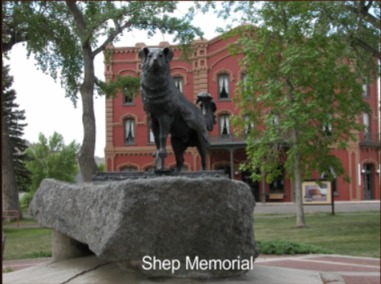
In the summer of 1936, a troubled sheepherder fell ill far from home and was brought to St. Clare Hospital in Fort Benton, Montana, accompanied by his devoted sheep dog.
When the man passed away, his family in the East requested that his body be shipped by train.
As the coffin was loaded onto the eastward train, that dog—later named Shep—stood watch.
He watched the casket go, heard the doors slam, saw the rails stretch away—and then a quiet vigil began.
Shep didn’t disappear. He didn’t wander off. He became a fixture of the railroad station, waiting for the train that carried his master.
Four times a day, every day, he came out to the platform, hopeful and expectant, to see if his master might return.
He sniffed the passengers, watched the arrivals, and held a quiet faith that somehow his person would come back again.
His loyalty didn’t go unnoticed. Station employees, railroad workers, and frequent travelers started caring for Shep.
They offered food scraps. They let him sleep under parts of the platform during storms.
Over time, Shep’s presence became legendary. Though many visitors offered to adopt him, Shep was never eager to leave his post.
His purpose was singular: to wait.
For more than five and a half years, through sweltering summers and brutal Montana winters, his vigil persisted.
He became gaunt, stiff-legged, nearly deaf—but he still climbed onto the platform.
When the snow bit and cold winds swept, he still showed. He still hoped. He still waited.

Then came that fateful morning in January 1942. Shep, old and fragile, failed to hear the rumble of a certain train arriving.
He turned late, slipped on icy rails, and was struck. His long watch ended abruptly. The town grieved.
The funeral was grand: many people attended, children were dismissed from school to pay their respects, and the Boy Scouts of Troop 47 served as pallbearers.
Shep was laid to rest on a hill overlooking the station he never left.
His story did not end with his death. Fort Benton embraced the legend. In 1942, a modest memorial was placed near the station.
In 1994, a bronze statue by Bob Scriver was unveiled in Shepherd’s Court, close to the Missouri River.
It shows Shep poised, front paws on the rail, gazing down the track—waiting still.
Surrounding it is a brick octagon, with engraved bricks and mini bronze statues memorializing loved ones or beloved pets.
The statue became a destination: a pilgrimage for dog lovers, for those who believe in loyalty, and for travelers enchanted by this true story.
Shep’s memory extended beyond monument and stone.
A “Shep Fund” was established: pamphlets telling his story were sold to train passengers, with proceeds donated to the Montana School for the Deaf & the Blind.
Over decades, that fund has continued, helping students that might otherwise lack resources.
His collar and bowl now sit in the Museum of the Upper Missouri as tangible relics of that devoted dog.

The identity of Shep’s original owner—or even much about his early life—remains mysterious.
Some records suggest Shep may have been an Australian Shepherd (or mixed breed), but other accounts say he more closely resembled a Border Collie—black with white, eyes hopeful.
What matters less is his breed than what he became: a symbol of fidelity, of loss, and of hope.
Photographs and film footage exist.
A 16mm reel from the early 1940s shows Shep greeting trains, doing tricks, walking onto the platform, and his funeral.
Through those images, the legend lives on—not just a memory, but a presence in the shared human imagination.
Today, people still travel to Fort Benton to see Shep’s gravesite or statue.
They walk the levee path, read the inscription “Forever Faithful,” and feel something hush over them: recognition of what loyalty really means.
He stands as a monument not just to one dog, but to the bond between humans and animals—the kind of devotion that outlasts time, travel, expectation, and even sound.
Shep’s story continues in books, local lore, postcards, and the hearts of those who read it.
He reminds us that sometimes the greatest love is one that waits silently, perhaps even hopelessly, but still refuses to leave its post.
Though his master never returned, Shep stayed. And in staying, he became immortal.



